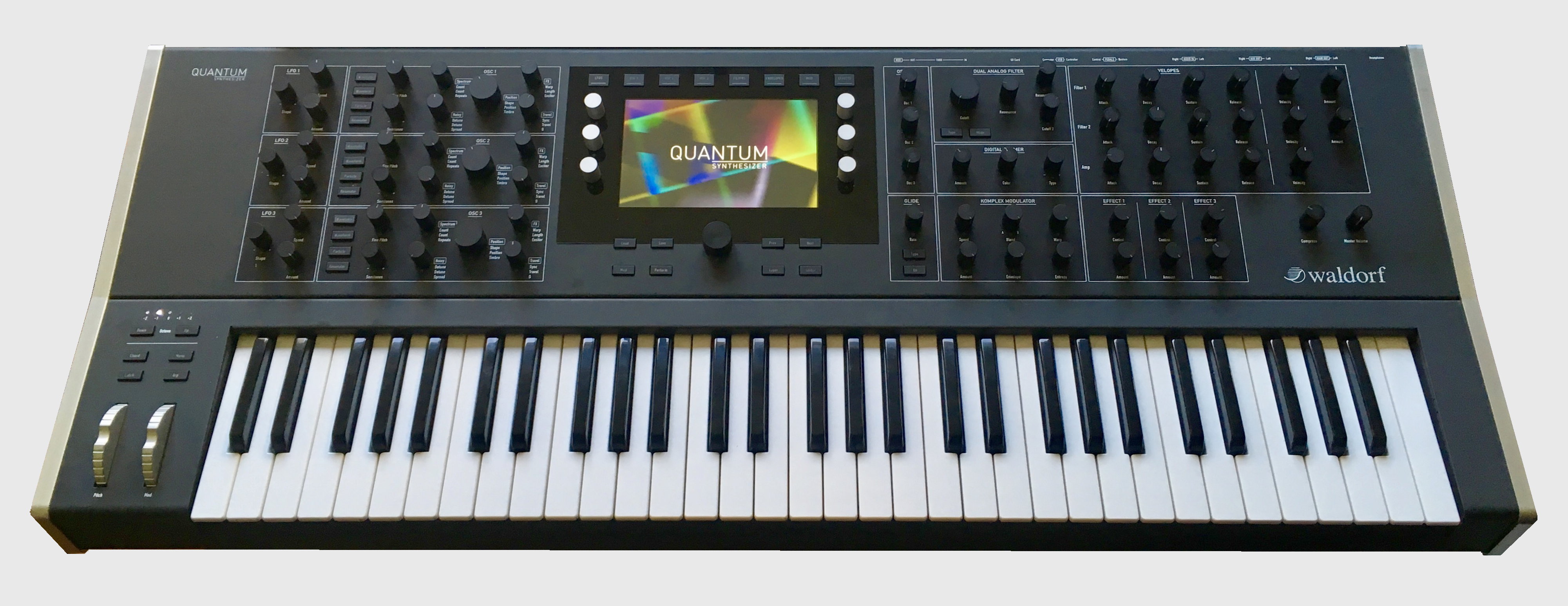|
Waldorf Music
Waldorf Music is a German synthesizer company best known for its Waldorf Microwave, Microwave wavetable synthesis, wavetable synthesizer and Waldorf Blofeld, Blofeld virtual analogue synthesizer. History Waldorf Electronics GmbH was founded in 1988 by Wolfgang Düren, who was then the German distributor for Palm Products Germany, PPG. The name "Waldorf" refers to the Germany, German town of Waldorf, Rhineland-Palatinate, Waldorf, located near Bonn, the former capital of West Germany, where the company was established. Later, the company was headquartered at Schloss Ahrenthal. After the demise of PPG in 1987, Waldorf carried forward the legacy of wavetable synthesis. Using an ASIC designed by Wolfgang Palm, the company developed the Microwave and later the WAVE synthesizers. However, Palm was never employed by Waldorf. The Microwave I, released in 1989, was based on ASICs and a Motorola 6800, Motorola MC68000 microprocessor. In contrast, the Microwave II, introduced in 1997, w ... [...More Info...] [...Related Items...] OR: [Wikipedia] [Google] [Baidu] |
Synthesizer
A synthesizer (also synthesiser or synth) is an electronic musical instrument that generates audio signals. Synthesizers typically create sounds by generating waveforms through methods including subtractive synthesis, additive synthesis and frequency modulation synthesis. These sounds may be altered by components such as filters, which cut or boost frequencies; envelopes, which control articulation, or how notes begin and end; and low-frequency oscillators, which modulate parameters such as pitch, volume, or filter characteristics affecting timbre. Synthesizers are typically played with keyboards or controlled by sequencers, software or other instruments, and may be synchronized to other equipment via MIDI. Synthesizer-like instruments emerged in the United States in the mid-20th century with instruments such as the RCA Mark II, which was controlled with punch cards and used hundreds of vacuum tubes. The Moog synthesizer, developed by Robert Moog and first so ... [...More Info...] [...Related Items...] OR: [Wikipedia] [Google] [Baidu] |
Virtual Studio Technology
Virtual Studio Technology (VST) is an audio plug-in software interface that integrates software synthesizers and effects units into digital audio workstations. VST and similar technologies use digital signal processing to simulate traditional recording studio hardware in software. Thousands of plugins exist, both commercial and freeware, and many audio applications support VST under license from its creator, Steinberg. Overview VST plugins generally run within a digital audio workstation (DAW), to provide additional functionality, though a few standalone plugin hosts exist that support VST. Most VST plugins are either instruments (VSTi) or effects (VSTfx), although other categories exist—for example spectrum analyzers and various meters. VST plugins usually provide a custom graphical user interface that displays controls similar to physical switches and knobs on audio hardware. Some (often older) plugins rely on the host application for their user interface. VST instrumen ... [...More Info...] [...Related Items...] OR: [Wikipedia] [Google] [Baidu] |
Integrated Circuit
An integrated circuit (IC), also known as a microchip or simply chip, is a set of electronic circuits, consisting of various electronic components (such as transistors, resistors, and capacitors) and their interconnections. These components are etched onto a small, flat piece ("chip") of semiconductor material, usually silicon. Integrated circuits are used in a wide range of electronic devices, including computers, smartphones, and televisions, to perform various functions such as processing and storing information. They have greatly impacted the field of electronics by enabling device miniaturization and enhanced functionality. Integrated circuits are orders of magnitude smaller, faster, and less expensive than those constructed of discrete components, allowing a large transistor count. The IC's mass production capability, reliability, and building-block approach to integrated circuit design have ensured the rapid adoption of standardized ICs in place of designs using discre ... [...More Info...] [...Related Items...] OR: [Wikipedia] [Google] [Baidu] |
Electronic Filter
Electronic filters are a type of signal processing filter in the form of electrical circuits. This article covers those filters consisting of lumped-element model, lumped electronic components, as opposed to distributed-element filters. That is, using components and interconnections that, in analysis, can be considered to exist at a single point. These components can be in discrete packages or part of an integrated circuit. Electronic filters remove unwanted frequency components from the applied signal, enhance wanted ones, or both. They can be: *Passive filter, passive or active filter, active *analogue filter, analog or digital filter, digital *high-pass filter, high-pass, low-pass filter, low-pass, band-pass filter, band-pass, band-stop filter, band-stop (band-rejection; notch), or all-pass filter, all-pass. *discrete-time (sampled) or Continuous signal, continuous-time *linear filter, linear or non-linear filter, non-linear *infinite impulse response (IIR type) or finite ... [...More Info...] [...Related Items...] OR: [Wikipedia] [Google] [Baidu] |
Low-pass Filter
A low-pass filter is a filter that passes signals with a frequency lower than a selected cutoff frequency and attenuates signals with frequencies higher than the cutoff frequency. The exact frequency response of the filter depends on the filter design. The filter is sometimes called a high-cut filter, or treble-cut filter in audio applications. A low-pass filter is the complement of a high-pass filter. In optics, high-pass and low-pass may have different meanings, depending on whether referring to the frequency or wavelength of light, since these variables are inversely related. High-pass frequency filters would act as low-pass wavelength filters, and vice versa. For this reason, it is a good practice to refer to wavelength filters as ''short-pass'' and ''long-pass'' to avoid confusion, which would correspond to ''high-pass'' and ''low-pass'' frequencies. Low-pass filters exist in many different forms, including electronic circuits such as a '' hiss filter'' used in audio, ... [...More Info...] [...Related Items...] OR: [Wikipedia] [Google] [Baidu] |
Analog Circuit
Analogue electronics () are electronic systems with a continuously variable signal, in contrast to digital electronics where signals usually take only two levels. The term ''analogue'' describes the proportional relationship between a signal and a voltage or current that represents the signal. The word ''analogue'' is derived from the Greek word meaning ''proportional''. Analogue signals An analogue signal uses some attribute of the medium to convey the signal's information. For example, an aneroid barometer uses the angular position of a needle on top of a contracting and expanding box as the signal to convey the information of changes in atmospheric pressure. Electrical signals may represent information by changing their voltage, current, frequency, or total charge. Information is converted from some other physical form (such as sound, light, temperature, pressure, position) to an electrical signal by a transducer which converts one type of energy into another (e.g ... [...More Info...] [...Related Items...] OR: [Wikipedia] [Google] [Baidu] |
Curtis Electromusic Specialties
Doug Curtis (March 8, 1951 – January 10, 2007) was the founder of Curtis Electromusic Specialties and OnChip Systems. Curtis was the designer of many original analogue ICs, used in a number of notable electronic music instruments. He was described in ''Keyboard'' as "one of the most important and least known synthesizer pioneers of the 20th century". Biography While attending high school, Curtis combined his aptitude for physics and mathematics with an interest in music and synthesizers to design and build an analog synthesizer. He attended Northwestern University's School of Communications, where he majored in radio/television/film and built several other synthesizers. Upon graduation, he qualified for a post as junior engineer by showing circuit boards of his designs. He entered a competition to design a semi-custom chip and won, resulting in a job at Interdesign, where he worked for four years. In 1979 he founded Curtis Electromusic Specialties (CEM), which produced the in ... [...More Info...] [...Related Items...] OR: [Wikipedia] [Google] [Baidu] |
PPG Wave
The PPG Wave is a series of synthesizers built by the German company Palm Products GmbH from 1981 to 1987. Background Until the early 1980s, the tonal palette of commercial synthesizers was limited to that which could be obtained by combining a few simple waveforms such as sine, sawtooth, pulse. The result was shaped with VCFs and VCAs. Wolfgang Palm transcended this limitation by pioneering the concept of wavetable synthesis, where single cycle waveforms of differing harmonic spectra were stored in adjacent memory slots. Dynamic spectral shifts were achieved by scanning through the waveforms, with interpolation used to avoid noticeable 'jumps' between the adjacent waveforms. Palm's efforts resulted in PPG's first wavetable synthesizer, the Wavecomputer 360 (1978), which provides the user with 30 different wavetables consisting of 64 waves each. While the expansive range of sound is evident, the absence of filters results in the Wavecomputer 360 sounding buzzy and thin, wh ... [...More Info...] [...Related Items...] OR: [Wikipedia] [Google] [Baidu] |
Wavetable Synthesis
Wavetable synthesis is a sound synthesis technique used to create quasi-periodic waveforms often used in the production of musical tones or notes. Development Wavetable synthesis was invented by Max Mathews in 1958 as part of MUSIC II. MUSIC II “had four-voice polyphony and was capable of generating sixteen wave shapes via the introduction of a wavetable oscillator.” Hal Chamberlin discussed wavetable synthesis in Byte's September 1977 issue. Wolfgang Palm of Palm Products GmbH (PPG) developed his version in the late 1970s and published it in 1979. The technique has since been used as the primary synthesis method in synthesizers built by PPG and Waldorf Music and as an auxiliary synthesis method by Ensoniq and Access. It is currently used in hardware synthesizers from Waldorf Music and in software synthesizers for PCs and tablets, including apps offered by PPG and Waldorf, among others. It was also independently developed by Michael McNabb, who used it in his 1978 ... [...More Info...] [...Related Items...] OR: [Wikipedia] [Google] [Baidu] |
19-inch Rack
A 19-inch rack is a standardized frame or enclosure for mounting multiple electronic equipment modules. Each module has a front panel that is wide. The 19 inch dimension includes the edges or ''ears'' that protrude from each side of the equipment, allowing the module to be fastened to the rack frame with screws or bolts. Common uses include computer servers, telecommunications equipment and networking hardware, audiovisual production gear, professional audio equipment, and scientific equipment. Overview and history Equipment designed to be placed in a rack is typically described as rack-mount, rack-mount instrument, a rack-mounted system, a rack-mount chassis, subrack, rack cabinet, rack-mountable, or occasionally simply shelf. The height of the electronic modules is also standardized as multiples of or one rack unit or U (less commonly RU). The industry-standard rack cabinet is 42U tall; however, many data centers have racks taller than this. The term relay rack ... [...More Info...] [...Related Items...] OR: [Wikipedia] [Google] [Baidu] |
Waldorf MicroWave (lowres)
Waldorf can have the following meanings: People * Stephen Waldorf (born 1957), film editor * William Waldorf Astor, 1st Viscount Astor (1848–1919), financier and statesman * Waldorf Astor, 2nd Viscount Astor (1879–1952), businessman and politician * Pappy Waldorf (1902–1981), 1966 College Football Hall of Fame inductee as a coach Communities Germany * Waldorf, Rhineland-Palatinate * Waldorf, a district in the town of Bornheim (Rheinland), North Rhine-Westphalia * Walldorf, a town in Baden-Württemberg United States * Waldorf, Maryland * Waldorf, Minnesota Hotels and restaurants * Waldorf Hotel (other), hotels named Waldorf ** Waldorf-Astoria (1893–1929), the original Waldorf Astoria in New York ** Waldorf Astoria New York, in New York ** Waldorf-Astoria (other), other Waldorf-Astorias ** The Waldorf Hilton, London * Waldorf Astoria Hotels & Resorts, a luxury hotel brand * Waldorf System or Waldorf Lunch, a chain of lunch rooms (1903-1970s) Educat ... [...More Info...] [...Related Items...] OR: [Wikipedia] [Google] [Baidu] |
String Synthesizer
A string synthesizer or string machine is a synthesizer designed to make sounds similar to those of a string section. Dedicated string synthesizers occupied a specific musical instrument niche between electronic organs and general-purpose synthesizers in the 1970s and early 1980s, until advances in digital signal processing technology allowed the production of inexpensive general-purpose polyphonic synthesizers and sampler (musical instrument), samplers, which made the existence of a separate type of instrument unnecessary. The development of the string synthesizer was originally motivated by the need for a cheaper and more portable alternative to the Mellotron, which was itself a cheaper alternative to human string ensembles. The availability of string synthesizers was influential in adding string orchestration to popular music that would not otherwise be able to afford the use of a human string ensemble, and their characteristic sound, which was almost, but not quite, like that ... [...More Info...] [...Related Items...] OR: [Wikipedia] [Google] [Baidu] |





